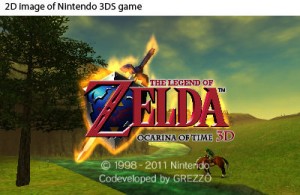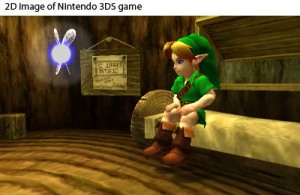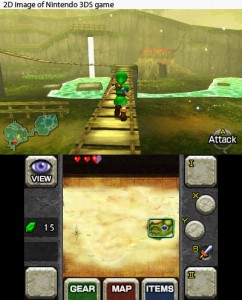Legend of Zelda: Ocarina of Time 3D Review (3DS)
- By Lewis Rayne
- Updated: 19th Jul, 2011
 Legend of Zelda: The Ocarina of Time. Few games connected generations on the same scale. This game was Link’s debut in 3D graphics. As such, it is only fitting that it ss also the first Zelda game to feature on Nintendo’s first stereoscopic 3D handheld. The question is just how well has it aged in the 13 years since it’s original release? Can it still be ranked amongst the champions of video games for gamers both new and old in true Nintendo style? The answer that shouts back is resoundingly positive. Just look at review aggregators like MetaCritic, where Legend of Zelda: The Ocarina of Time 3D currently sits on a healthy 94/100 metascore.
Legend of Zelda: The Ocarina of Time. Few games connected generations on the same scale. This game was Link’s debut in 3D graphics. As such, it is only fitting that it ss also the first Zelda game to feature on Nintendo’s first stereoscopic 3D handheld. The question is just how well has it aged in the 13 years since it’s original release? Can it still be ranked amongst the champions of video games for gamers both new and old in true Nintendo style? The answer that shouts back is resoundingly positive. Just look at review aggregators like MetaCritic, where Legend of Zelda: The Ocarina of Time 3D currently sits on a healthy 94/100 metascore.
For those who are among the younger generation of gamers, or anyone who hasn’t played the original, Ocarina of Time follows the adventures of young Link. He awakens one morning to find himself hand-picked by the great Deku tree, the benevolent protector of the forest in which the Kokiri people live. His task? To venture out into the big world, meet a princess and save everyone from the impending doom being spearheaded by pointy-nosed Ganon. All a rather low pressure situation for Link. He handles it with a demeanor befitting of a hero, all the time rocking the green hat.
Graphically, Ocarina of Time has been given a huge boost into portable space with sweeping crisp curves replacing blocky jagged edges and walls that don’t give you a headache to look at. This kind of graphical improvement is beyond the realms of a simple port, or at least any I have had the pleasure of dealing with. Of course, with this being the 3DS, 3D is one of the main focuses. As with most other 3DS titles the 3D is mainly used for depth of field effects. Simple sights like the Deku tree show off their true scale and grandeur with the 3D turned on. Ocarina of Time is pleasant to play with the 3D turned up; its soft graphics compliment the 3D in a way that doesn’t present too many headaches. This time around your helpful fairy friend Navi provides helpful reminders to take a break or even watch a hint movie.Some of you who played the original will now be confused. I can already hear the slightly bitter tone of voice mutter about how gamers didn’t need hint videos back in the day so why should we now. Some of the puzzles and dungeons were gruelling; it was the trend at the time – this doesn’t mean it has to continue. I’m not trying to say that the game has been made easier. In fact, the opposite is true in that it is still the same puzzles as it had before. Good job it has been 13 years between playthroughs for the hardcore fans.
The point is that hint videos are now available for those that want them via Sheikah stones; they look like the gossip stones of the original but allow you to crawl inside for a quick hint at the future. Navi, helpful as ever, offers her advice, usually to the tune of “That door has a barrier” or some other obvious statements. Helpful for those who are truly stuck but the seasoned adventurer shouldn’t get too stuck… at least not until the later temples.
The fine balance of Combat, Exploration and Story is expertly managed during Ocarina of Time’s 23+ hours of gaming time. The combat follows a simple attack and block format which would get boring if it wasn’t for the multitude of weapons available to dispatch the equally varied number of enemies, each of course having a different weakness of way of defeating them. Weapons like the slingshot and other projectiles use the 3DS gyroscope to aim; by moving the console you move your viewpoint. Simple stuff but it works brilliantly compared to other gyro-controlled games I have tried. The gyroscope works in the same manner for both the Shield (for blocking enemy attacks) and a first-person area view when exploring.
This brings me to one of my favourite parts of this 3D reboot, the touchscreen. If I could insert a smiley here to depict my joy at using this new menu system it would probably look something like this XD. The new menu system is sleek and easy to use with a map in the middle, your equipped items on the right and Navi on the left. Items can be assigned to any of the 3 face keys plus 2 extra touch slots. Simply tap an item to equip and tap again to unequip. Simple, fast and efficient; the perfect menu system, no?If you are the type of gamer that likes hunting for collectables or hidden items then Ocarina of Time has you covered. There are spiders, hearts, weapons and all manner of things scattered around the game’s 21 locales. Some items are important to the narrative and others aren’t. All, however, are good fun to hunt down if you wish to stray from your path for a while. The majority of collectables come at the behest of the worlds denizens, usually after performing a fetch quest in typical adventure fashion.
There isn’t much more to The Legend of Zelda: Ocarina of Time but really there doesn’t need to be. The story is paced brilliantly and the combat is a perfect mix of different methods; repetitive enough to be familiar but varied enough to keep things fresh. I used to hold the opinion that The Legend of Zelda: Ocarina of Time was a classic game and a memento to how games used to be. Having played it again I am pleased to say that 13 years later it is still as fresh as when it was first released. This level of freshness doesn’t just come from a new coat of paint or new features, it comes from a game that, like its hero, goes on a journey through time and comes out stronger then it was before. If you own a 3DS and love adventurous hijinks then Ocarina of Time is for you.
Legend of Zelda: Ocarina of Time 3D is available now on Nintendo 3DS
About Lewis Rayne
Lewis thrives on pressure and life just isn’t exciting enough for him. That might be why he games so much. Despite being an avid gamer and writer he has never finished a Sonic game past the first world and has accepted the fact he probably never will. Lewis writes words for those that want them.



Follow Us!